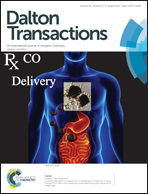Metal ion influences distortion of the ligand in the structure of [M{2-MeO(O)CC6H4NHC(S)NP(S)(OiPr)2}2] (M = ZnII, CdII) complexes: a driving force for intermolecular aggregation†‡
Abstract
Reaction of the in situ deprotonated N-thiophosphorylated thiourea 2-MeO(O)CC6H4NHC(S)NHP(S)(OiPr)2 (HL) with MCl2 (M = ZnII, CdII) in aqueous ethanol leads to complexes of the formula [ML2]. Both compounds crystallise in the triclinic space group P![[1 with combining macron]](https://www.rsc.org/images/entities/char_0031_0304.gif) with Z = 2 and the metal cations are found in a tetrahedral S2S′2 coordination environment formed by the C–S and P–S sulfur atoms. The crystal structures reveal intramolecular N–H⋯O
with Z = 2 and the metal cations are found in a tetrahedral S2S′2 coordination environment formed by the C–S and P–S sulfur atoms. The crystal structures reveal intramolecular N–H⋯O![[double bond, length as m-dash]](https://www.rsc.org/images/entities/char_e001.gif) C hydrogen bonds formed within the 2-MeO(O)CC6H4NH fragments. Both structures are further stabilised by intermolecular π⋯π stacking interactions, which are more efficient in [CdL2]. Here, a pronounced dimeric intermolecular aggregate is observed which goes along with a pronounced distortion of the chelate [(S)CNP(S)]− backbone of the ligand upon coordination to CdII as well as a significantly distorted coordination tetrahedron CdS2S′2. The aggregation is also reflected in the positive electrospray ionisation (ESI) mass spectrum of the CdII complex, which exhibits peaks for the dimeric cations [Cd2L3]+, [Cd2L4 + H]+ and [Cd2L4 + Na]+, while for the ZnII analogue only monomeric species were observed. Quantum chemical ETS-NOCV (ADF) calculations confirm the higher stability of dimers in [CdL2] compared with [ZnL2]. The π⋯π stacking interactions are prodominantly due to dispersion contributions, though the electrostatic and orbital interaction components are also important. QTAIM (ADF) type calculations additionally quantify the covalent and non-covalent interactions in the momomers.
C hydrogen bonds formed within the 2-MeO(O)CC6H4NH fragments. Both structures are further stabilised by intermolecular π⋯π stacking interactions, which are more efficient in [CdL2]. Here, a pronounced dimeric intermolecular aggregate is observed which goes along with a pronounced distortion of the chelate [(S)CNP(S)]− backbone of the ligand upon coordination to CdII as well as a significantly distorted coordination tetrahedron CdS2S′2. The aggregation is also reflected in the positive electrospray ionisation (ESI) mass spectrum of the CdII complex, which exhibits peaks for the dimeric cations [Cd2L3]+, [Cd2L4 + H]+ and [Cd2L4 + Na]+, while for the ZnII analogue only monomeric species were observed. Quantum chemical ETS-NOCV (ADF) calculations confirm the higher stability of dimers in [CdL2] compared with [ZnL2]. The π⋯π stacking interactions are prodominantly due to dispersion contributions, though the electrostatic and orbital interaction components are also important. QTAIM (ADF) type calculations additionally quantify the covalent and non-covalent interactions in the momomers.
![Graphical abstract: Metal ion influences distortion of the ligand in the structure of [M{2-MeO(O)CC6H4NHC(S)NP(S)(OiPr)2}2] (M = ZnII, CdII) complexes: a driving force for intermolecular aggregation](/en/Image/Get?imageInfo.ImageType=GA&imageInfo.ImageIdentifier.ManuscriptID=C5DT02189H&imageInfo.ImageIdentifier.Year=2015)

 Please wait while we load your content...
Please wait while we load your content...